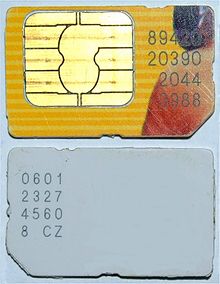
In addition to the battery, GSM mobile phones require a small microchip, called a Subscriber Identity Module or SIM Card, to function. Approximately the size of a small postage stamp, the SIM Card is usually placed underneath the battery in the rear of the unit, and (when properly activated) stores the phone's configuration data, and information about the phone itself, such as which calling plan the subscriber is using. When the subscriber removes the SIM Card, it can be re-inserted into another phone that is configured to accept the SIM card[31] and used as normal.
Each SIM Card is activated by use of a unique numerical identifier; once activated, the identifier is locked down and the card is permanently locked in to the activating network. For this reason, most retailers refuse to accept the return of an activated SIM Card.
Those cell phones that do not use a SIM Card have the data programmed in to their memory. This data is accessed by using a special digit sequence to access the "NAM" as in "Name" or number programming menu. From here, one can add information such as a new number for the phone, new Service Provider numbers, new emergency numbers, change their Authentication Key or A-Key code, and update their Preferred Roaming List or PRL. However, to prevent someone from accidentally disabling their phone or removing it from the network, the Service Provider puts a lock on this data called a Master Subsidiary Lock or MSL.
The MSL also ensures that the Service Provider gets payment for the phone that was purchased or "leased". For example, the Motorola RAZR V9C costs upwards of CAD $500. Depending on the carrier, such a phone may be available for as little as $200. The difference is paid by the customer in the form of a monthly bill. If the carrier did not use an MSL, then they may lose the $300–$400 difference that is paid in the monthly bill, since some customers would cancel their service and take the phone to another carrier.
The MSL applies to the SIM only so once the contract has been completed the MSL still applies to the SIM. The phone however, is also initially locked by the manufacturer into the Service Providers MSL. This lock may be disabled so that the phone can use other Service Providers SIM cards. Most phones purchased outside the US are unlocked phones because there are numerous Service Providers in close proximity to one another or have overlapping coverage. The cost to unlock a phone varies but is usually very cheap and is sometimes provided by independent phone vendors.
Having an unlocked phone is extremely useful for travelers due to the high cost of using the MSL Service Providers access when outside the normal coverage areas. It can cost sometimes up to 10 times as much to use a locked phone overseas as in the normal service area, even with discounted rates. T-Mobile will provide a SIM unlock code to account holders in good standing after 90 days according to their FAQ.
For example, in Jamaica, an AT&T subscriber might pay in excess of US$1.65 per minute for discounted international service while a B-Mobile (Jamaican) customer would pay US$0.20 per minute for the same international service. Some Service Providers focus sales on international sales while others focus on regional sales. For example, the same B-Mobile customer might pay more for local calls but less for international calls than a subscriber to the Jamaican national phone C&W (Cable & Wireless) company. These rate differences are mainly due to currency variations because SIM purchases are made in the local currency. In the US, this type of service competition does not exist because some of the major Service Providers do not offer Pay-As-You-Go services. [Needs Pay-As-You-Go references, rumored T-Mobile, Verizon provide one, AT&T does not as of 12/2008]



0 comments:
Post a Comment